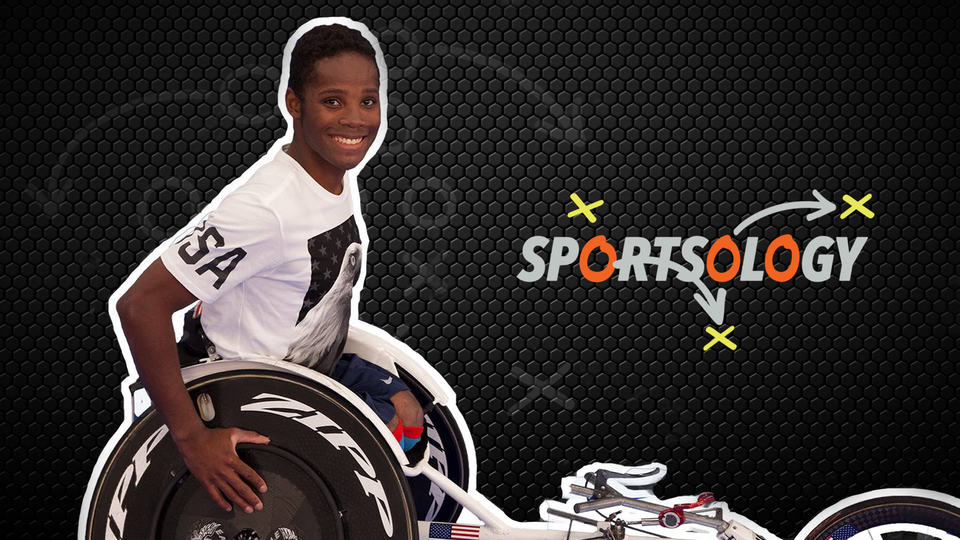
Mark Braun shares what it’s like to be an adaptive athlete
At the Science Museum, we believe that science is for everyone. And a part of science we’re passionate about is movement and sports, which is why we created Sportsology. By studying how your body moves through play, you can better understand how elite athletes do what they do. Just like science, we believe that sports are for everyone, too.
By saying sports are for everyone, we mean everyone. People of any age, race, gender, sexual orientation, nationality, and ability should be able to experience the fun and hard work that come with playing sports. That’s why we interviewed Sportsology star and Team USA track and field paralympic athlete, Mark Braun, to get his take on what it means to do sports and how he hopes to inspire the next generation of athletes.
If you don’t know Mark, you wouldn’t know that he was born in Jamaica with a congenital anomaly called spina bifida, a developmental condition that affects the spinal cord, and he was adopted into a family here in the United States. Mark is number three in his event (100 meters) in the US and in the top 50 paralympic track and field athletes in the world. So yes, he’s a pretty big deal. Wheelchair racing is a unique sport. Unlike typical track and field races, adaptive wheelchair racers only use their upper body to propel themselves and their wheelchair. They aren’t allowed to use any mechanical assistance or motors, and yet they still reach speeds up to 18 miles per hour during a race! Aerodynamics are extremely important for paralympic athletes. When Mark races, he leans forward in his chair to accelerate and reduce drag, helping him speed forward to the finish line. You can read more of Mark’s backstory here—we want to focus on his experiences being a professional paralympic athlete, advice for the next generation, and future goals for accessibility in sports.
Mark, what is it like to be a professional athlete?
It’s both rewarding and hard work. The rewarding part of it is that you get to see the results of everything that you do. It’s really about how much you put into it that becomes a reward. If you only put the bare minimum in, that’s what you get. If you put in the maximum effort, you’ll see glowing results. For me, training can be a really difficult part of being an athlete. I don’t have anyone of my caliber to train with here in Minnesota, and with COVID, many gyms and indoor training areas have been closed. But still, I know that I have to keep training to do better. Now that I train other athletes, I am definitely the “Do as I say, not as I do coach.” I definitely have days where I don’t want to train!
Are there barriers for people who want to get into sports? Which obstacles did you face?
No matter what walks of life you’re in, you’re always going to have barriers. Whether it’s getting started, traveling, training. For me here in Minnesota, it’s hard to find a training venue—I have to train on the road and not indoors. One big barrier many people face is getting support to pursue sports beyond youth. Your success really depends on the support you have in your state or from a program that could help propel you forward when you’re an adult. It makes it hard for people if support stops at adulthood.
What would you say to encourage other people with disabilities to try out sports?
No matter what, even if you come to a roadblock, don’t stop. If you’re passionate about something, go and get it.
Tell us about your dreams for the future.
I am passionate about giving everyone the same opportunities. I am hoping to create two non-profits. The first one would be focused on giving a voice to the voiceless. In countries like Jamaica, many orphans are disabled, and they do not have anyone to be a voice for them, to advocate for them. I want to help lift them out of poverty, provide them with opportunities, and get them on their feet to succeed. A human is a human: we all have hearts, dreams, and passions. I didn’t have a voice when I was in an orphanage in Jamaica, so now that I’m adopted and in the US, I want to give back.
My second non-profit would be an elite adaptive (and non-adaptive) sports program. Before I got on Team USA, I remember what it was like to pay for all of my travel, expenses, hotels, everything, when it came to sports. I want to eliminate the barriers for families that are low income, no matter if the athlete is adaptive or non-adaptive. Rookie athletes of all walks of life have trouble going pro because of funding, and without major success, most companies won’t sponsor you. No matter what kind of success you’ve had in the past, every person deserves a chance. This non-profit would support athletes by paying for their fees and ensuring that all they have to focus on is training and competing.
The future of sports for everyone
While COVID-19 is changing how sports work around the world, moving our bodies is just as important now as it was before the pandemic. Listen to Mark when he says, “No matter what, even if you come to a roadblock, don’t stop.” Below is a list of accessible trails and outdoor spaces for everyone to explore, adaptive sports programs in Minnesota, as well as a fun activity to help you understand your heart rate.

